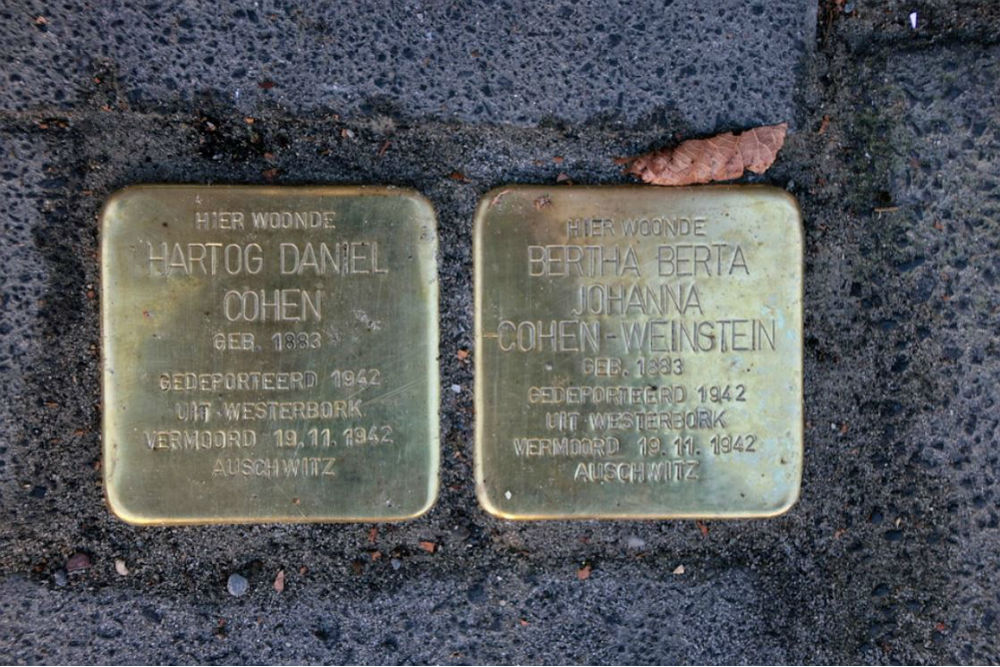Stumbling Stones H.W. Mesdagstraat 46A
These small brass memorial plaques (stolpersteine or stumbling stones) commemorate a husband and wife who lived here:
Hartog Daniel Cohen
Born on 29-05-1883 in Leer (Germany)
Deported to Westerbork on 12-11-1942
Murdered in Auschwitz on 19-11-1942
Bertha Berta Johanna Cohen-Weinstein
Born on 24-02-1883 in Gensungen (Germany)
Deported to Westerbork on 12-11-1942
Murdered in Auschwitz on 19-11-1942
Hartog Daniel Cohen was a butcher and cattle dealer. He married Bertha Berta Johanna Weinstein, and in 1908 they lived in Leer, Germany, where he had been born. They had a daughter, Rachel Renate Cohen. Hartog was registered in 1902 with the Dutch military. He applied for and was approved for naturalization in 1920 but did not move to the Netherlands then. Again in 1929 his application was approved, but he and Bertha still remained in Germany.
After daughter Rachel married Benno Schwartz, those two moved to Vaals, NL, in 1935. They had one child, Charles Karl Schwartz, born in 1936.
Hartog and Bertha Cohen finally moved to the Netherlands in 1938, and in March 1939 his name was on the register for this address, H.W. Mesdagstraat 46A. They were both taken to Westerbork on 12 November 1942. Four days later they were deported to Auschwitz and murdered there on 19 November.
Rachel Schwartz-Cohen and her son Charles Schwartz were murdered in Auschwitz on 31 August 1942 – the day before his 6th birthday. Husband/Father Benno Schwartz survived the war but was very ill from his time in a concentration camp. He died in 1949.
"Stolpersteine" is an art project for Europe by Gunter Demnig to commemorate victims of National Socialism (Nazism). Stolpersteine (stumbling stones) are small, 10x10cm brass plaques placed in the pavement in front of the last voluntary residence of (mostly Jewish) victims who were murdered by the Nazis. Each plaque is engraved with the victim’s name, date of birth, and place (mostly a concentration camp) and date of death. By doing this, Gunter Demnig gives an individual memorial to each victim. One stone, one name, one person. He cites the Talmud: "A human being is forgotten only when his or her name is forgotten."
Do you have more information about this location? Inform us!
Source
- Text: Bert Deelman & Anne Palmer
- Photos: Suzanne Matrosov-Vruggink (1), Bert Deelman (2)
- Biografie Familie Cohen
- Stolpersteine.eu
Nearby
Point of interest
- Remembrance place H.W. Mesdagstraat 3 - Groningen
- Bullet Impact Taco Mesdagstraat 41 - Groningen
- Bullet Impact Wassenberghstraat 18 - Groningen
Monument
- War Monument Schilderswijk - Groningen
- Memorial Post Office Groningen - Groningen
- Memorial Academy Building University - Groningen
Cemetery
- Dutch War Graves Northern Cemetery - Groningen
- Commonwealth War Graves Groningen - Groningen
- Dutch War Graves Zuiderbegraafplaats - Groningen
Remembrance Stone
- Stumbling Stones Taco Mesdagstraat 23a - Groningen
- Stumbling Stones Jozef Israëlsstraat 44 - Groningen
- Stumbling Stones Kraneweg 44a - Groningen
Fortification
- German Shelter Suikerunie Factory - Groningen
- German Tobruk Bunker Suikerunie Factory - Groningen
- German Bunker Haren - Haren




